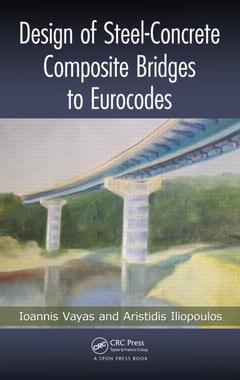Design of Steel-Concrete Composite Bridges to Eurocodes
Auteurs : Vayas Ioannis, Iliopoulos Aristidis

Combining a theoretical background with engineering practice, Design of Steel-Concrete Composite Bridges to Eurocodes covers the conceptual and detailed design of composite bridges in accordance with the Eurocodes. Bridge design is strongly based on prescriptive normative rules regarding loads and their combinations, safety factors, material properties, analysis methods, required verifications, and other issues that are included in the codes. Composite bridges may be designed in accordance with the Eurocodes, which have recently been adopted across the European Union. This book centers on the new design rules incorporated in the EN-versions of the Eurocodes.
The book addresses the design for a majority of composite bridge superstructures and guides readers through the selection of appropriate structural bridge systems. It introduces the loads on bridges and their combinations, proposes software supported analysis models, and outlines the required verifications for sections and members at ultimate and serviceability limit states, including fatigue and plate buckling, as well as seismic design of the deck and the bearings. It presents the main types of common composite bridges, discusses structural forms and systems, and describes preliminary design aids and erection methods. It provides information on railway bridges, but through the design examples makes road bridges the focal point.
This text includes several design examples within the chapters, explores the structural details, summarizes the relevant design codes, discusses durability issues, presents the properties for structural materials, concentrates on modeling for global analysis, and lays down the rules for the shear connection. It presents fatigue analysis and design, fatigue load models, detail categories, and fatigue verifications for structural steel, reinforcement, concrete, and shear connectors. It also covers structural bearings and dampers, with an emphasis on reinforced elastomeric bearings. The book is appropriate for structural engineering students, bridge designers or practicing engineers converting from other codes to Eurocodes.
Introduction. Types of steel–concrete composite bridges. Design codes. Actions. Basis of design. Structural materials. Modeling and methods for global analysis . Buckling of plated elements. Ultimate limit states. Serviceability limit states. Fatigue. Shear connection. Structural bearings, dampers, and expansion joints. Index.
Ioannis Vayas is professor and director of the Institute of Steel Structures at the National Technical University of Athens. He graduated in civil engineering at the same university and received his Dr-Ing from the Technical University of Braunschweig, Germany, and his welding engineering specialization from SLV Hannover, Germany. He has been involved in research, national and European codification, and consultancy on steel structures and bridges for over 30 years.
Aristidis Iliopoulos
is a structural engineer and received his Dr-Ing from Ruhr University Bochum, Germany. He has participated in numerous projects such as longspan roofs, steel–concrete composite bridges, and steel buildings in seismic areas. He is also a member of the CEN/TC 250/SC3 and CEN/TC 250/SC4 Working Groups for steel and composite bridges.Date de parution : 08-2013
17.8x25.4 cm
Date de parution : 05-2017
17.8x25.4 cm
Thème de Design of Steel-Concrete Composite Bridges to Eurocodes :
Mots-clés :
Shear Connectors; Deck Slab; Bridge engineering; Composite Bridges; Composite structures; Steel Girders; Steel-concrete design; Main Girders; Limit state design; Bottom Flange; Simply supported bridge; Shear Buckling; Two-span continuous bridge; Plate Buckling; closely spaced encased girders; Lateral Torsional Buckling; Elastomeric Bearings; Longitudinal Stiffeners; Composite Cross Section; Effective Width Method; Cross Girders; Reduced Stress Method; Shear Lag; Box Girders; Composite Section; Elastomeric Layers; kN kN kN; Partial Safety Factor; Warping Torsion; Transverse Stiffeners; Stiffening Girders; Plastic Stress Distribution



